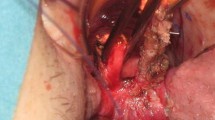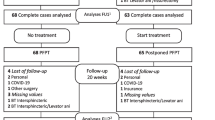Abstract
Background
Anal incontinence is experienced by some patients with rectal cancer who received low anterior resection. This study was to examine the efficacy and adverse effects of the alpha-1 adrenergic agonist phenylephrine, which causes contraction of the internal anal sphincter and raises the resting pressure in these patients.
Patients and methods
Thirty-five patients with anal incontinence were treated with 30% phenylephrine or a placebo randomly allocated in a double-blind study. The efficacy of the drug was assessed by changes in the following standardized questionnaire scores: the fecal incontinence severity index (FISI), fecal incontinence quality of life (FIQL) scales, and a global efficacy question. Anal sphincter function was evaluated using anorectal manometry.
Results
Phenylephrine did not improve either the FISI score or any of the four FIQL scores. Five of 17 (29%) patients reported subjective improvement after phenylephrine compared with 4 of 12 (33%) using the placebo. The maximum resting anal pressure did not differ between baseline and after 4 weeks application of phenylephrine (30.0 to 27.3 mmHg). In the phenylephrine group, allergic dermatitis was developed in five patients and headache in two.
Conclusion
In the patients with anal incontinence after low anterior resection for rectal cancer, phenylephrine gel did not seem to be helpful in relieving symptoms with some adverse effects.

Similar content being viewed by others
References
McAnena OJ, Heald RJ, Lockhart-Mummery HE (1990) Operative and functional results of total mesorectal excision with ultra-low anterior resection in the management of carcinoma of the lower one-third of the rectum. Surg Gynecol Obstet 170:517–521
Williamson ME, Lewis WG, Finan PJ, Miller AS, Holdsworth PJ, Johnston D (1995) Recovery of physiologic and clinical function after low anterior resection of the rectum for carcinoma: myth or reality? Dis Colon Rectum 38:411–418
Graf W, Ekstrom K, Glimelius B, Pahlman L (1996) A pilot study of factors influencing bowel function after colorectal anastomosis. Dis Colon Rectum 39:744–749
Williams N, Seow-Choen F (1998) Physiological and functional outcome following ultra-low anterior resection with colon pouch-anal anastomosis. Br J Surg 85:1029–1035
Nesbakken A, Nygaard K, Lunde OC (2001) Outcome and late functional results after anastomotic leakage following mesorectal excision for rectal cancer. Br J Surg 88:400–404
van Duijvendijk P, Slors F, Taat CW, Heisterkamp SH, Obertop H, Boeckxstaens GE (2003) A prospective evaluation of anorectal function after total mesorectal excision in patients with a rectal carcinoma. Surgery 133:56–65
Horgan PG, O’Connell PR, Shinkwin CA, Kirwan WO (1989) Effect of anterior resection on anal sphincter function. Br J Surg 76:783–786
Molloy RG, Moran KT, Coulter J, Waldron R, Kirwan WO (1992) Mechanism of sphincter impairment following low anterior resection. Dis Colon Rectum 35:462–464
Tsunoda A, Shibusawa M, Kusano M (1999) Anorectal function after anterior resection with side-to-side anastomosis for carcinoma of the rectum. Dis Colon Rectum 42:77–81
Morgan B, Patel B, Beynon J, Carr ND (1997) Surgical management of anorectal incontinence due to internal anal sphincter deficiency. Br J Surg 84:226–230
Sentovich SM, Rivela LJ, Blatchford GJ, Christensen MA, Thorson AG (1995) Patterns of male fecal incontinence. Dis Colon Rectum 38:281–285
Hallgren T, Fasth S, Delbro DS, Nordgren S, Oresland T, Hulten L (1994) Loperamide improves anal sphincter function and continence after restorative proctocolectomy. Dig Dis Sci 39:2612–2618
Ho YH, Chiang JM, Tan M, Low JY (1996) Biofeedback therapy for excessive stool frequency and incontinence following anterior resection or total colectomy. Dis Colon Rectum 39:1289–1292
Regadas FS, Batista LK, Albuquerque JL, Capaz FR (1993) Pharmacological study of the internal and sphincter in patients with chronic anal fissure. Br J Surg 80:799–801
O’Kelly TJ, Brading A, Mortensen NJ (1993) In vitro response of the human anal canal longitudinal muscle layer to cholinergic and adrenergic stimulation: evidence of sphincter specialization. Br J Surg 80:1337–1341
Carapeti EA, Kamm MA, Evans BK, Phillips RK (1999) Topical phenylephrine increases anal sphincter resting pressure. Br J Surg 86:267–270
Carapeti EA, Kamm MA, Nicholls RJ, Phillips RK (2000) Randomized, controlled trial of topical phenylephrine for anal incontinence in patients after ileoanal pouch construction. Dis Colon Rectum 43:1059–1063
Badvie S, Andreyev HJ (2005) Topical phenylephrine in the treatment of radiation-induced faecal incontinence. Clin Oncol 17:122–126
Carapeti EA, Kamm MA, Phillips RK (2000) Randomized controlled trial of topical phenylephrine in the treatment of faecal incontinence. Br J Surg 87:38–42
Rockwood TH, Church JM, Fleshman JW, Kane RL, Mavrantonis C, Thorson AG et al (1999) Patient and surgeon ranking of the severity of symptoms associated with fecal incontinence: the fecal incontinence severity index. Dis Colon Rectum 42:1525–1532
Rockwood TH, Church JM, Fleshman JW, Kane RL, Mavrantonis C, Thorson AG et al (2000) Fecal incontinence quality of life scale: quality of life instrument for patients with fecal incontinence. Dis Colon Rectum 43:9–16
Yamato S, Rattan S (1990) Role of alpha adrenoceptors in opossum internal anal sphincter. J Clin Invest 86:424–429
Jehle EC, Haehnel T, Starlinger MJ, Becker HD (1995) Level of the anastomosis does not influence functional outcome after anterior rectal resection for rectal cancer. Am J Surg 169:147–152
Macmillan AK, Merrie AE, Marshall RJ, Parry BR (2004) The prevalence of fecal incontinence in community-dwelling adults: a systematic review of the literature. Dis Colon Rectum 47:1341–1349
Cheetham MJ, Kamm MA, Phillips RK (2001) Topical phenylephrine increases anal canal resting pressure in patients with faecal incontinence. Gut 48:356–359
Author information
Authors and Affiliations
Corresponding author
Rights and permissions
About this article
Cite this article
Park, JS., Kang, SB., Kim, DW. et al. The efficacy and adverse effects of topical phenylephrine for anal incontinence after low anterior resection in patients with rectal cancer. Int J Colorectal Dis 22, 1319–1324 (2007). https://doi.org/10.1007/s00384-007-0335-6
Accepted:
Published:
Issue Date:
DOI: https://doi.org/10.1007/s00384-007-0335-6




